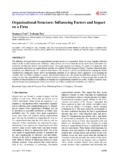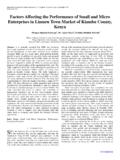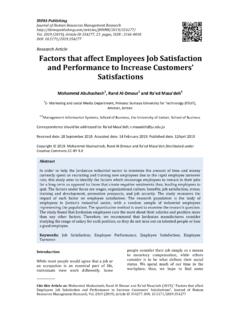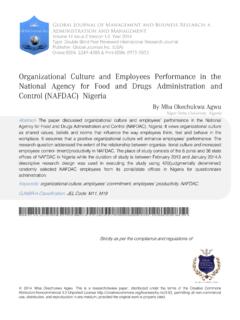Transcription of Strategic HRD Practices as Key Factors in Organizational ...
1 Strategic HRD Practices as Key Factors in Organizational Learning Chien-Chi Tseng Gary N. McLean University of Minnesota Relationships between Strategic HRD Practices and Organizational learning were explored through a literature review. Organizations that learn and develop their SHRD Practices have more opportunities to obtain and integrate the nine SHRD outcomes in the learning process: Organizational missions and goals, top management leadership, environmental scanning, HRD strategies and plans, Strategic partnerships with line management, Strategic partnerships with HRM, trainers as Organizational change consultants, influence corporate culture, and emphasis on individual productivity and participation. Keywords: Strategic HRD Practices , Organizational Learning, HRD Effective organizations have employees who are committed and make contributions to Organizational success. Hale (1991) pointed out that human resource development (HRD) professionals must support Organizational learning in order to establish performance expectations, address higher-level problem-solving skills, and account for societal outcomes.
2 Thus, HRD professionals are primarily responsible for creating HRD strategies within a learning culture that fosters continuous employee learning. This indicates that HRD professionals need to adopt a new approach to maximizing Organizational effectiveness, one that addresses the real problems of an organization and enables it to achieve learning results (Rothwell, 1996). So what does this new approach look like to enable organizations to achieve learning results and adopt the new approach? By organizing, integrating, and evaluating previously published material identified in a comprehensive literature review, this research identified the relationship between Strategic HRD (SHRD) Practices and Organizational learning. We argue, first, that SHRD has a responsibility to provide strategies, training, and development opportunities to help organizations and their employees to achieve their business goals.
3 Then, we argue that the characteristics of SHRD are important in providing Organizational learning. We also believe that SHRD Practices have the same responsibilities to influence Organizational learning as to provide organizations with the key capabilities to enhance their Organizational outcomes related to SHRD Practices . Problem Statement The concept of SHRD has been explored by several authors in recent years (Becker, Huselid, & Ulrich, 2001; Ericson, 2006; Garavan, Costine, & Heraty, 1995; Gilley & Eggland, 1989; Gilley & Maycunich, 2000; Grieves, 2003; Harrison, 1997; Lee, 2003; Nadler & Wiggs, 1986). For example, Ericson (2006) stated that to be engaged in SHRD on an ontological level requires an understanding of hermeneutical significance; Lee (2003) argued that HRD practice is about addressing the underlying assumptions of human conditions and influencing human conditions. To almost the same extent, the role of Organizational learning or learning organization has been much discussed in the literature (Beer & Eisenstat, 1996; Brinkerhoff & Gill, 1994; Dixon, 1994; Gardiner & Sadler-Smith, 2001; G mez, Lorente, & Cabrera, 2004; Klimencki & Lassleben, 1998; Sadler-Smith, Spicer, & Chaston, 2001; Williams, 2001).
4 These studies were used to examine how Organizational learning helps employees attain performance results that enable them to accomplish their personal goals and objectives. For example, Sadler-Smith, Spicer, & Chaston (2001) stated that Organizational learning as the development or acquisition of new knowledge or skills in response to internal or external stimuli that leads to a more or less permanent change in collective behavior, enhancing Organizational outcomes. However, there is a need to develop a wholistic perspective of the way in which SHRD practice relates to Organizational learning. Although several studies have highlighted the positive effects of certain HR Practices on Organizational learning, there is a lack of studies that explore SHRD Practices broadly and their relation to Organizational learning. Although several works have emphasized the effects of certain SHRD Practices in Organizational learning (Gilley & Maycunich, 2000; Grieves, 2003; Wang & Wang, 2004), there is a lack of a complete conception or model that examines the entire relationship and related outcomes.
5 Therefore, because the outcomes are important for business success, understanding the relations among SHRD Copyright 2007 Chien-Chi Tseng & Gary N. McLean Practices , Organizational learning, and Organizational outcomes would be a valuable contribution. Research Question and the Significance This research clarifies the relationship between SHRD Practices , Organizational learning, and Organizational outcomes by exploring the following four research questions: 1. What are the key Factors of SHRD Practices in Organizational learning? 2. Can Strategic HRD Practices help to maximize Organizational outcomes by embracing Organizational learning? 3. What is the relationship between Organizational learning and Strategic HRD Practices ? 4. What are the implications of Strategic HRD Practices for the workplace? HRD professionals need to develop an approach that helps the organization focus on their Strategic business goals.
6 Such an approach must focus on Organizational learning and the key Factors that it influences. In this study, the key Factors are SHRD Practices (Brinkeerhoff & Gill, 1994). In an Organizational learning context, strategy emphasizes the importance and critical nature of employees and organizations in achieving their business goals and Organizational effectiveness. To fulfill this objective, SHRD needs to be well organized and planned, as well as integrated into every aspect of the organization. Therefore, the above research questions have demonstrated the significance of this approach. Definitions Definitions are provided below for HRD, SHRD Practices , and Organizational learning. HRD Several definitions have been provided for human resource development (HRD) during the past few decades (Gilley & Eggland, 1989; Lee, 2003; McCracken & Wallace, 2000; McLean & McLean, 2001; Nadler, 1983; Nadler & Wiggs, 1986; Smith, 1988; Swanson, 1995).
7 There are three areas of professional practice including learning, performance, and change that are generally identified in the definitions of HRD. For example, Swanson (1995) defined HRD as a process of developing and unleashing human expertise through organization development and personal training and development for the purpose of improving performance (p. 207). Nadler (1983) defined HRD as organized learning experiences in a given period of time to bring about the possibility of performance change or general growth for the individual and the organization (p. 1). McLean and McLean (2001) described HRD in a global perspective: Human resource development is any process or activity that, either initially or over the long term, has the potential to knowledge, expertise, productivity and satisfaction, whether for personal or group/team gain, or for the benefit of an organization, community, nation or, ultimately, the whole of humanity.
8 (p. 322) Most definitions include, at minimum, the need for Organizational efforts to result in performance improvement and organization development that enhance the organization s competitiveness and effectiveness SHRD Practices Garavan et al. (1995) contended that HRD is used in many contexts and widely differing activities. Gilley and Eggland (1989) concluded that HRD is an organized learning activity within the organization used to improve performance and personal growth for the purpose of improving the job, the individual, and the organization. The key definition of SHRD used in this article is Garavan s (1991): SHRD is the Strategic management of training, development, and of management or professional education interventions, so as to achieve the objectives of the organization while at the same time ensuring the full utilization of the knowledge in detail and skills of individual employees.
9 Furthermore, SHRD is extensively concerned with practice. It is broader than other trends, including workforce scorecard, ROI work, and human resource management (HRM). Huselid, Becker, and Beatty (2005) used the term Workforce Scorecard to highlight the focus on the Strategic performance of employees rather than the contribution of the HR function to business success. In addition, Glick (2004) argued that ROI is straightforward as a financial ratio, but it can also be accurately adapted to represent the value of employee training or new software investment. Furthermore, Cardy, Gove, and DeMatteo (2000) highlighted job structure changes and a heightened customer orientation as two primary concepts that necessitate adaptation of HRM Practices . SHRD, with its focus on proactive change management, can help organizations survive in an increasingly global, unstable, and competitive environment (Grieves, 2003).
10 Several key elements, including critical thinking (Patterson, Crooks, & Lunyk-Child, 2002), evaluation (Torres & Preskill, 2001), Strategic hiring and training (P rez L pez, Pe n, & Ord s, 2006), participation (Wang & Wang, 2004), and credibility (Ulrich, 1997), serve as a road map for SHRD practice and provide SHRD professionals with a clear path to establish value and performance in their organizations. Garavan (1991) accented the point that the need for integration into business planning is critical for SHRD, as is a contribution to corporate goals and an awareness of mission. Then, he suggested that the support and active participation of top management, as key stakeholders, is vital for the development of SHRD. In addition, he argued that continuous knowledge of the external environment, in terms of opportunities and threats for the business and for HRD, specifically, is vital for SHRD to flourish.
















